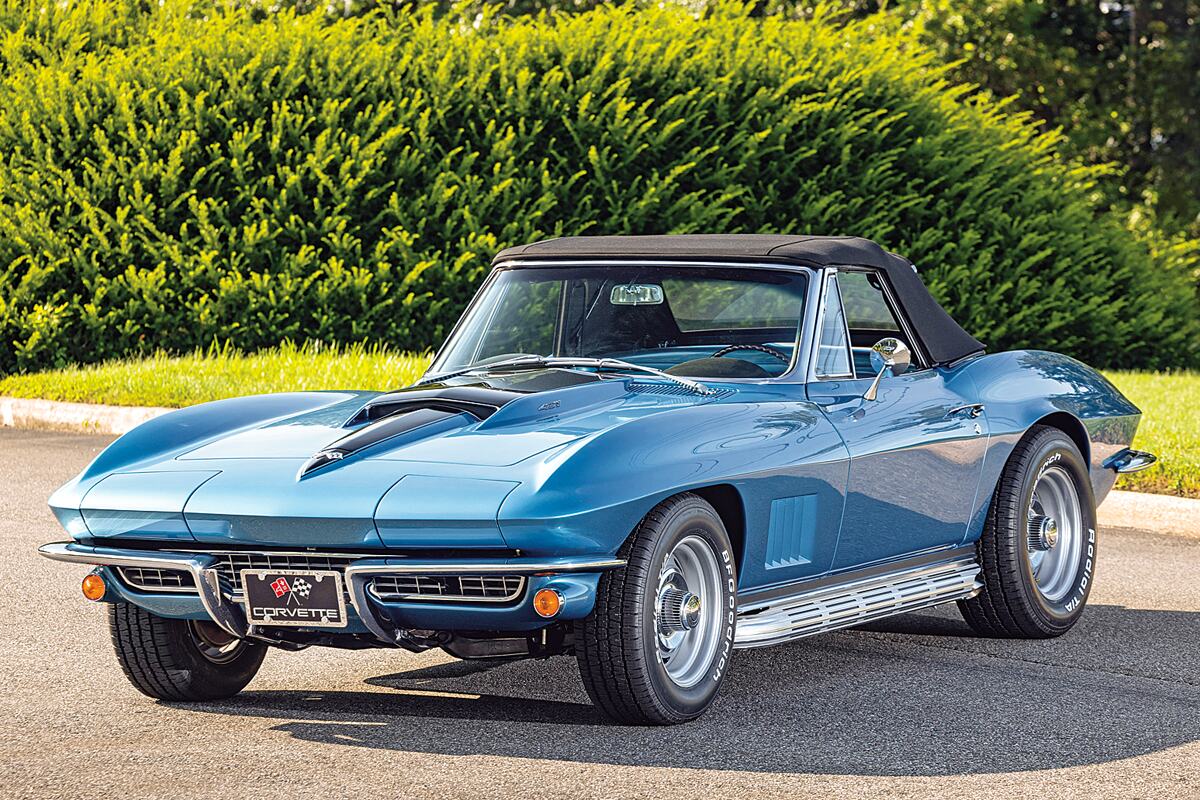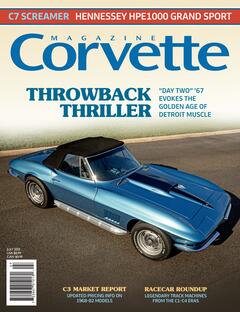Car customizing, which is nearly as old as the automobile itself, arguably reached its zenith in the period stretching from the conclusion of World War II to the mid-1970s. Advances in mass production, spurred on by the necessities of wartime, combined with a widespread prosperity and the rise of the Baby Boomers to fuel the aftermarket industry during this time. But the promulgation of federal safety, fuel economy, and exhaust emissions that began in earnest in the early 1970s—followed by the adoption of computer controls for engines, transmissions, and nearly everything else a couple of decades later—put a serious crimp in the hobby.
Corvettes from the 1950s and ’60s were not immune from customization during the pastime’s golden era, and in fact were modified at a higher rate, and to a greater degree, than most other cars. This was due to several factors, among them the car’s wealthy buyer demographic, the passion those owners possess for the brand, and the relative ease with which fiberglass body panels can be reshaped. Looking back, we’d guess that around half of the C1 and C2 Corvettes sold in the U.S. were altered in some way almost immediately after delivery, giving rise to the term “day two” modifications.
The most popular changes, particularly for 1963-67 models, included fender flares, a “ducktail” spoiler on the rear deck, the addition of a third taillight on either side, fixed headlights, and the removal of the bumpers. But as popular as these changes were in their time, the prevailing trend since the early 1980s has been to erase such modifications entirely and return vintage Corvettes to stock form.

After 40-plus years of reversing the customizing done from the 1950s to the 1970s, it’s extremely unusual to find an early Corvette still wearing its period mods. It’s even rarer to see particularly desirable and valuable vintage Vettes modified this way, because these alterations can diminish such a car’s market value significantly. This is precisely why our feature car is so interesting. It’s a documented 1967 L71 427/435-horsepower convertible that still retains its original engine—and its period modifications.
The mods, which include mildly flared rear quarter panels, along with the aforementioned triple taillights and a small ducktail, were done in the late 1960s or very early ’70s. In the mid-’70s the car was partially disassembled for general restoration and repair work. But because it was not yet in vogue to return modified C2s to their factory configuration, the custom tweaks were not slated to be reversed during the resto. In any case, the work stalled and the car remained in storage, mostly disassembled, in a residential garage in Queens, New York, for the next half century.
The principals at CMC/Dream Cars, a noted restoration facility in Plainview, New York, learned about the forlorn ’67 Tri-Power big-block several years ago, and in July 2023 they cemented a deal to buy it. They planned to reassemble the car, completely restoring its functionality while preserving its period modifications.

“Personally, I like the modifications,” explains company co-founder Chris Mazzilli, “and we’re seeing an increasing number of people who feel the same way. It’s consistent with the trend toward high-end restomods. People are less interested in adhering to very strict rules dictating that the cars need to be exactly as they were when they left the assembly plant, and are more interested in cars that are a lot of fun to drive and that remind them of their younger years, when custom Corvettes were the norm. It’s particularly meaningful when a car’s modifications were actually done back in the day, as is the case with this ’67.”
When CMC/Dream Cars was around a third of the way through the car’s rehabilitation, Mazzilli contacted Greg Lotko, a longtime customer whom he thought might be interested in buying it. Mazzilli sent some photos of the car, and Lotko showed those to a business colleague named Jeff Henry, who happened to be sitting next to him in a meeting. Like Lotko, Henry is a passionate car enthusiast and CMC/Dream Cars customer.
“I took one look at the photos of the car,” recalls Henry, “and told Greg that 1967 was my favorite-year Corvette, convertibles my favorite body style, Marina Blue my favorite color, and a big-block with side pipes exactly what I’d always wanted.”

Interestingly, Henry’s first love was the iconic 1963 “Split Window” coupe, a model he obsessed over as a child. He built scale models of the legendary C2, collected magazine stories about it, and had posters depicting it on his bedroom walls. But there was a big problem with the object of Henry’s desire. The bifurcated rear window was a coupe-only feature, and Henry is non-negotiable when it comes to his fervor for convertibles.
“As much as I love the styling of the ’63 coupe, I love putting the top down and enjoying open-air driving even more,” he says. “That steered me away from Split Windows toward Midyear convertibles, and the 427 “stinger” hood unique to 1967 is what turned that into my absolute favorite year.”
Moved by Henry’s passion, Lotko said he would pass on the car and allow his friend to buy it. Henry quickly finalized a deal and had CMC/Dream Cars continue the restoration they had already begun. He did, however, make a few changes to the master plan, most notably with regard to the interior. The car was originally fitted with black cabin upholstery, and it was still thus configured when acquired by CMC/Dream Cars. Henry wanted a white interior, but felt it would look odd combined with a black hood stinger. Since he didn’t want to do any paint work, he opted to spice up the palette a bit with the installation of bright blue seat covers and door panels. He also had the shop paint the shifter console blue.

“If I had them install a white interior,” he explains, “I would have asked them to change the hood stinger to white. But the paint is so nice I didn’t want to touch it, so we went with what’s essentially a two-tone interior. The blue seats, door panels, and center console match the blue body, and the black dash pads and carpeting match the black hood stinger, tying it all together. And I replaced the white convertible top with a new black top to match the stinger, dash, and carpet.”
The only other significant change inside the car involved the sound system, where the original AM/FM radio gave way to a RetroSound unit. Though it is the same size and vertical orientation as the original, and thus looks correct for the car, the new stereo offers improved sound quality and modern conveniences, including Bluetooth connectivity.
On the mechanical front, the focus was on improving the car’s drivability and reliability. To that end the rear suspension was rebuilt with a lightweight fiberglass transverse spring instead of the factory multi-leaf steel spring. The fiberglass spring is shorter than the original it replaced, to allow more clearance for wider wheels and tires. It works in conjunction with a custom rear anti-sway bar and offset trailing arms that are also engineered to provide clearance for fatter rubber.

The stock spare-tire carrier had to be slightly modified to make room for the new sway bar, but otherwise no changes were required to accommodate the revised rear suspension. Both the spring and trailing arms, as well as the rear sway-bar setup, were sourced from Van Steel.
Up front, most of the suspension and steering components were in new condition, having been replaced when work began on the car in the 1970s. CMC/Dream Cars installed new coil springs to achieve the correct ride height, and replaced some of the bushings and other rubber components simply because of their age, but otherwise left the stock front end alone.
The flares, offset trailing arms, and shorter rear spring provide enough space to comfortably fit beefy 255/65R15 tires at the rear. The fronts are sized at 215/65R15, which is the largest feasible spec without making additional modifications to the body. In keeping with the car’s “day two” flavor, the tires are BFGoodrich Radial T/As.
Because Henry fully intended to drive the car on a regular basis, including on the highway, its four-speed Muncie manual gearbox was replaced with a five-speed Tremec transmission that works in conjunction with a Ram hydraulic clutch. The former provides an overdrive Fifth gear that, along with 3.36:1 rear gears in place of the factory 4.11:1 set, makes high-speed cruising a breeze. While the new, numerically lower ring-and-pinion ratio gives up something in terms of off-the-line performance, the voluminous torque delivered by this 427-cube engine still allows for impressive acceleration.
As for the big-block, though it had been rebuilt at some point in the distant past, its 50-year stint in storage convinced the team at CMC/Dream Cars to go through it again. They had the bores freshened, the crankshaft ground and polished, the main bearing saddles align-honed, the rods and heads reconditioned, and the reciprocating assembly balanced. They also rebuilt all three of the carburetors, which were almost certainly leaking and in a poor state of tune after an extended period of disuse.
After reassembly the engine was run on a dynamometer to ensure proper break-in and measure output. Horsepower peaked at 453.4 at 5,200 rpm, and torque maxed out at 533.8 pound-feet at 3,500 rpm. More telling than the peak torque figure, however, was the width of the torque curve: the engine produced more than 400 lb-ft all the way up to about 5,500 rpm.
All work was completed in February 2025, and in keeping with the plan from the beginning, Henry is driving the car on a regular basis. “It’s exactly what I dreamed about as a child,” he says, “and every bit as much fun to drive as I expected.”





